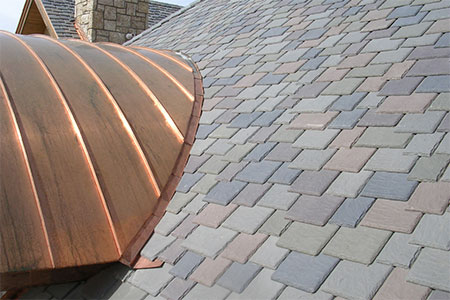The History of Slate Colors and Home Styles
by Kate Smith, Color Expert and Trends Forecaster
The look of slate is loved by homeowners around the globe. But, when it comes to color, one small region right here in the USA is considered The Colored Slate Capital of the World. This region, known as Slate Valley, is about six miles wide and extends approximately 24 miles along the New York/Vermont border.
In this area, the chemical and mineral composition produces a rare variety of colors—green, gray, gray black, purple, mottled green and purple, and red. Slate Valley is the only place in the world where nature produces these colors.
The desire for the distinctive appearance of slate, coupled with the characteristic colors found only in the USA, made slate a preferred choice for early American homeowners. Today's homeowner has even more nature-inspired colors to choose from when building a new early American style home. How can you help your homeowner clients determine which slate roofing color to choose?
The best way to get to the answer to that question is to first focus on the style that inspired the home design you're constructing. Then find out what colors were used when styles like this were originally built. You may also want to look at whether homes of this style typically had a single color or multi-color roof, and then make suggestions based on this information.
The Slate Gray
Bellaforté roof from
DaVinci Roofscapes on this home, inspired by early American style, sets this home apart in the marketplace.
American Slate History Background
Here is what I found to be the most common slate colors on American homes built from 1785 to the early 1900's. Think about this information as you start constructing homes that replicate this period of time.
In the earliest style homes in America—Colonial, Federal and Neoclassical—slate was not often used because it was not widely available. These homes were roofed originally with wood shingles instead. Occasionally, slate would be found on homes of this style if they were built close to where slate was being quarried. The color would vary on what was found locally.
For example, in Vermont and New York there are many different colors of slate—greens, greys, black, purples and red. These same quarries also produced slate mottled with two or more colors—such as green and purple, and grey and black, for example. In Virginia, the slate is more of a blue-black, whereas slates produced in Pennsylvania are very dark black. Even within the same area, slate quarries could yield different colors, and even within a single quarry different colors were extracted.
With a varied palette with hints of red and blue, the European color blend of this
Multi-Width Slate roofing provides a lightly mottled, natural look that complements the home's traditional, hipped roofline.
The Look of Slate on Today's Homes
In today's marketplace, you don't have to worry about trekking to the Northeast to select real slate. Companies like DaVinci Roofscapes offer polymer slate (and shake!) roofing products in a wide range of colors.
Looking at homes of Colonial, Federal and Neoclassical styles, you'll see they have replaced their original shake roofs with slate. The most popular choices seem to be grey or black roofs. If you want to be a bit more adventurous—while remaining true to the period of the home you're building—you could investigate what other slate choices might have been found in the area at the time your home style was originally built.
Gaining popularity a little later in the 19th century, Greek Revival homes also typically originally had wooden shingles in most areas of the country. The exception to this was the Northeast, where slate was quickly gaining popularity. These homes had a variety of colors, depending on what was being extracted from the nearest quarry, but the most common colors were black and grey, followed by red, blue, purple and green.
About 1840, the Gothic Revival style was gaining popularity and the railway was enabling the slate industry in America to have wider distribution. The quarries started producing more roofing slate to meet growing demand. Slate was considered the material of choice for Gothic Revival homes. Dark single color slate and later multi-color slate patterns that mixed in purple, green, red and blue adorned the Gothic style.
Second Empire, with its characteristic mansard roof, was also often clad in slate. For most homes a single darker slate or variations of lights to darks in a single hue was used. Some buildings and homes also employed various colors in a pattern on the roof.
Victorian homes were built to impress. They used various slate colors and combinations of roofing styles that included towers and turrets. Like the many colors used to accentuate the trim, multi-color roofs were used for emphasis. Purple, blue and green were popular choices to mix with grey or black to adorn this style of home.
The Aberdeen color of
Multi-Width Slate creates a bold and colorful roof that is sure to be noticed. Paired with other classic touches like this decorative copper, a home can be transformed.
Synthetic Slate Makes It Easy
With today's polymer slate products, builders can breathe a sigh of relief. Gone are the inherent problems of real slate—cracking, brittleness and the very heavy weight. Synthetic slate roofing materials have all of the beauty of natural slate shingles, but none of the shortcomings.
Plus, a huge benefit of using manufactured slate is that you can choose from all of the colors once only available regionally. Each of the 50 colors available from DaVinci Roofscapes replicates those naturally quarried slates throughout history. With their natural appearance, even the "boldest" color choice of a polymer slate will look at home on any early American architectural styles.



.png)
.png)




